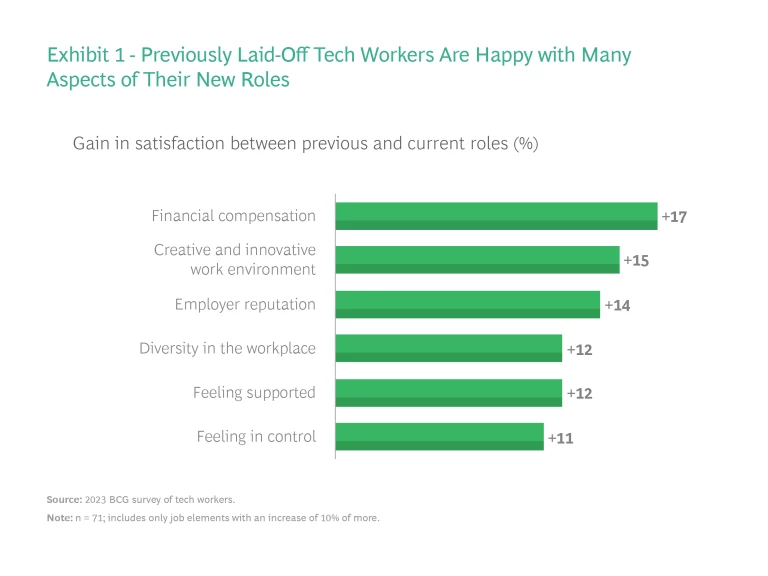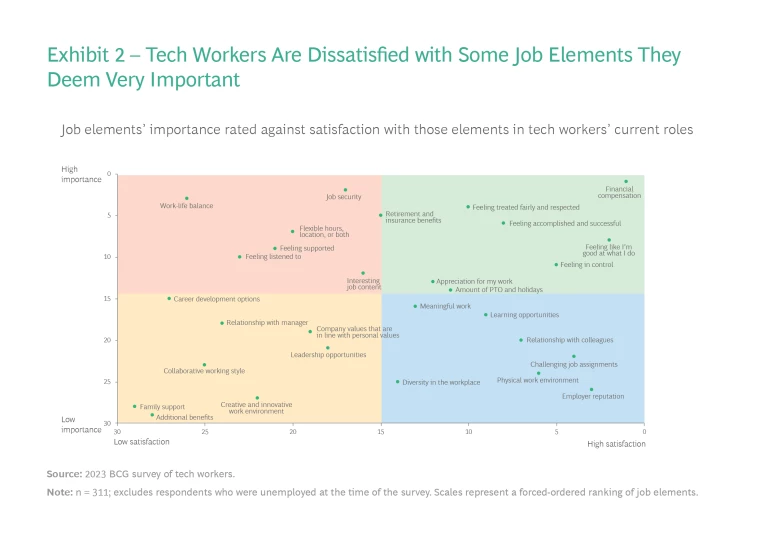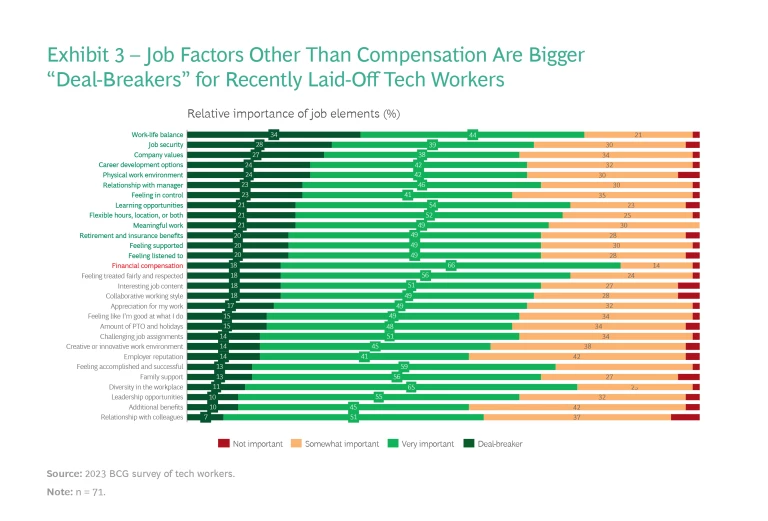Hiring laid-off technology workers isn’t as easy as companies outside the tech industry may expect.
The vast majority of tech workers who lost tech-industry jobs are working again, according to new BCG research on tech talent trends. Not only that, most stayed in the tech industry and are satisfied with compensation and other aspects of their new roles.
But companies in other industries looking for tech talent to fuel innovation and digital transformations still have an opportunity to win over tech workers. The majority—not just those recently re-employed—are actively looking or passively open to making a job switch. Many would consider working outside the tech industry. A recruiter might have put it best when they said of traditional companies’ tech talent prospects: “It’s still a good time to make a strategic move.”
To capitalize on the moment, companies have to do more than offer attractive compensation. They must also provide the aspects of work that tech talent appreciates but often lack, including work-life balance, flexibility, and interesting assignments. They must also modernize their often-outdated recruiting practices to successfully compete with tech firms.
Laid-Off Tech Workers Found Employment but Are Open to New Opportunities
Tech industry layoffs weren’t the magic hiring bullet companies in other industries might have hoped for. Although tech-industry layoffs have been substantial, the total includes a significant portion of people outside of tech roles. Of all tech-industry workers affected by layoffs, only 22% were software engineers, according to industry
COLLIDING TRENDS ARE AFFECTING TECH TALENT
During the pandemic, tech companies drastically increased hiring in tech and other roles to meet surging demand for online services. Since mid-2022, however, tech companies have cut an estimated 250,000 jobs, reflecting the need to operate more efficiently amid economic and geopolitical uncertainties and other destabilizing factors.
Challenging times for big tech may be creating opportunities for companies outside the tech industry that need people with the right skills to design and implement digital transformations, tech migrations, and digital strategy overhauls. Demand for tech talent has significantly outdistanced supply, particularly in areas such as data science, AI, and machine learning. It’s tough for companies outside the tech industry to hire the talent they need—and to hang onto it once they do.
On top of that, the tech talent that these companies require is changing. In years past, companies outside the tech industry needed in-house workers with project management skills to supervise core technical work done by outside vendors. Today, more companies want to own their own intellectual property. They need tech talent with skills in generative AI, full-stack engineering, problem-solving, and next-generation ways of working.
In addition, companies are expanding where they recruit and hire tech workers. Historically, companies prioritized hiring in regions where they could attract skilled tech talent for less pay. Today, they are prioritizing tapping into talent pools with the right skills, wherever they are. Companies also are hiring in regions where they can collocate tech talent with employees in other functions to improve collaboration, or in regions where tech talent is closer to end users or customers. Companies also are looking for opportunities to hire tech talent in regions with geopolitical allies, something that’s come to be known as “friend-shoring.”
To learn more about the state of the tech workforce and what companies outside the tech industry can do to attract this in-demand talent pool, in early 2023, BCG surveyed 815 tech workers in a variety of technology roles in the US (551) and Germany (264). Of the total, 52% had jobs with tech companies, and 48% worked in tech roles at companies in other industries. Out of all respondents, around 12% had been laid off from tech industry jobs in the previous nine months.
The tech workers we polled held a variety of roles, including in IT infrastructure, networking, and cybersecurity; IT consulting; IT operations; data and analytics, machine learning and AI; app and web development; tech support; and product management.
We found:
Most laid-off tech landed new jobs and improved their positions. Nine out of 10 tech workers who’d been laid off from jobs in the tech industry were working again by the time of our survey. Of those with new positions, 94% remained within the technology industries.

Individuals hired into new roles did well for themselves. They reported being more satisfied than they had been in the past with their financial compensation. (See Exhibit 1.) They were also happier with the creativity and innovation in their work environment, and their employer’s reputation, and felt more supported and in control of their work.
Forty percent of respondents who were laid off and found new roles in the tech industry took jobs at startups. It’s possible they traded higher salaries for more equity or were attracted to a role where they could have more ownership or make a greater impact. They also could have been attracted to a less “corporate” environment, with less red tape and greater control over work routines. For potential employers, tech workers’ willingness to work at a startup indicates that offering compelling work and a clear employee value proposition (EVP) can be a big draw for a talent pool that is otherwise tough to attract.
Tech workers in new roles are still open to a job change. Of all the tech workers in our survey, 70% were open to considering a new position. That so many tech workers are open to new opportunities could be related to the fact they are often contacted by recruiters about new opportunities, especially people with skills in niche areas or subspecialties. The large percentage of rehired tech workers open to a new position could also be related to how much stock this talent pool puts in interesting and creative work, so much so that they would jump to a different position for the chance to work on something new or innovative.
Tech workers who found new employment after being laid off were even more open to a job change than the average. A full 90% reported either actively looking for a new role or being passively open to one. Of that number, more than 60% would consider job opportunities outside of the tech industry.

Tech workers are dissatisfied with certain job factors. Tech workers report having their needs met in areas such as compensation, feeling respected and accomplished, and in control of their work. (See Exhibit 2.)
However, they are dissatisfied with other high-priority job factors. Among them: work-life balance, flexibility in when and where they work, feeling listened to and supported, job security, and having interesting work to do.
We dug deeper to understand how tech workers who had been laid off felt about various job elements that they deemed important. We found that although tech workers who were laid off but were now employed reported being satisfied in some areas, there are other areas where employers could do better. (See Exhibit 3.)

The largest number of previously laid-off tech workers said compensation was a “very important” job factor (66%). However, a significant number ranked other job factors as “deal- breakers.” These must-haves included work-life balance, job security, retirement benefits, company values that line up with their personal values, career development and learning opportunities, and feeling in control. It could imply that these workers see generous compensation as a baseline and chose a new job based on other factors.
For companies outside of tech that might not be able to match tech industry salaries, it’s an opportunity to appeal to tech talent through other job elements that could be incorporated into and highlighted as part of their employee value proposition.
Tech talent want work that matters. Having work that’s interesting, innovative, or meaningful in some other way is hands down more important to tech talent than to people in other professions. In a different BCG survey of 90,000 people in a cross-section of industries about their job preferences, we found that 27% said having exciting things to work on was part of their ideal career path. However, among the 6,000 tech workers included in the total, that figure was much higher—52% said exciting work was a priority.
Companies outside the field could use this to their advantage. For example, a company could attract an engineer working on an extremely narrow subfunction at a tech giant by offering them the chance for work that’s much broader or central to the company’s core business.
Geography affects tech talent preferences. Tech talent isn’t a monolith. Demographics, economics, and regional industries and work norms affect tech workers’ job preferences, including whether they would consider working at companies in other industries. For example, US and German tech workers both rank factors such as feeling treated fairly and compensated well at the top of their list. However, US tech workers are far more concerned about layoffs than their German counterparts (69% versus 51%), a possible consequence of societal safety nets and common workforce policies and practices in EU countries that make jobs more secure and layoffs less frequent.
The differences don’t end there. Tech workers in Germany are more open to considering tech jobs at companies in other fields, possibly because the country’s tech industry isn’t as prominent as automotive and industrial goods sectors, which have significant numbers of tech-related jobs. In addition, German tech workers rank having meaningful work among the three job elements they value most, compared with US tech workers, who rank it 15th. On the other hand, US tech workers place work-life balance and job security among their top three most important job elements, but German tech workers ranked them 11th and 12th respectively, a possible outcome of the same employment practices and social safety nets mentioned above.
Five Tactics to Attract Tech Talent
Employers outside the tech industry can take appropriate action to make themselves more attractive to tech workers.
Reinvent your employee value proposition to meet tech talent needs. We know from our research that tech workers appreciate financial compensation more than almost any other aspect of work, so meeting baseline expectations for compensation is a must. However, tech workers have been through the proverbial wringer over the past year, and companies looking to hire them should take that into account. Create a holistic employee value proposition that includes people-centric elements that tech workers appreciate but report not getting enough of. Those include support for work-life balance, career development, and opportunities for learning new skills. Learning and development could be a good place to invest if current offerings aren’t strong.
Offering flexibility is another way companies can stand out. Even before the pandemic, tech workers often had more flexibility to work remotely or at hours of their choosing. Offering that level of flexibility can be a draw at a time when employers in tech and other fields are instituting stricter return-to-office policies.
Finally, knowing how much tech workers appreciate having interesting projects, companies should play up the “wow” work they’re doing that tech recruits would be drawn to. They could, for example, emphasize the modern tools and innovative ways of working they offer. They could also host case competitions, create micro-internships, and invite potential job candidates for on-site visits.
Take the long view of hiring—and layoffs. Tech workers coming from the tech industry are often expensive hires. Companies outside the tech industry looking for tech talent to power digital transformations or other initiatives have to be judicious about who is needed to fulfill their objectives on budget. If you’re staffing a scrum team for a major new project, you might not need a dozen A-level tech workers who’ve put in time at tech giants; just one could act as team leader or culture carrier and set the bar for the others. A skills-based workforce plan can determine how talent demand matches current supply, to make hiring more strategic. Such a plan also ties skills and positions to business strategy.
In the same vein, layoffs may be unavoidable to deal with economic pressures or help restructure a workforce for the future. If that’s the case, be equally strategic about job cuts. Instead of implementing across-the-board cuts or freezes, use a workforce plan to determine key roles to keep growing. Take advantage of opportunities to fill positions as economically as possible, by promoting from within, reskilling, or finding laid-off tech talent with amazing skills willing to trade better job security for slightly less compensation.
Use 21st-century recruiting methods. Tech workers move fast when it comes to making job-related decisions, as our findings show. Contrast that with antiquated recruiting practices that traditional companies continue to follow despite newer, more systematic approaches and the widespread availability of modern recruiting technology. Failing to update recruiting methods and systems hurts companies’ efforts by preventing them from quickly identifying talent who are actively or passively looking.
Updating recruiting isn’t just about using cutting edge, AI-based sourcing tools or the latest applications. It also includes getting the basics right. Adopt streamlined, standardized practices for sourcing and screening candidates. Give hiring managers interview guides so they link interview questions to job roles. Clarify who has the authority to make a quick hiring decision. A recruiting application with a centralized database of past and present candidates and scheduling capabilities makes it easy to act fast if the situation warrants it, for example, to set up interviews with someone newly on the market who’s applied before and has been pre-screened for baseline qualifications.
Live your values. The best way for a company to show its employee value proposition is to live it. The most eloquently crafted EVP is meaningless if current employees can’t corroborate it, and new hires don’t experience it. Companies can start by addressing obvious gaps: if you claim to offer mobility—opportunities for transfers, rotations, or a move to a different role—make sure it’s easy for employees to find out about and make use of the opportunity. Create cross-functional strike teams to evaluate and improve key employee experiences such as onboarding, career pathing, and learning and development. Give people autonomy to change their day-to-day norms. Show employees you appreciate them and reward their contributions. Celebrate aspects of the EVP to remind employees why they make the right choice to stay with the company.
Insist supervisors train to be generative managers. We know from previous BCG research that employees’ relationships with their managers affects satisfaction with their daily work and work environment. During the pandemic era, despite the switch from in-person to virtual meetings, digital workers—including tech workers—placed even more importance than in the past on maintaining good relationships with supervisors and colleagues. But the sad truth is that managers often get only bare-bones training on effective and empathetic leadership, especially in tech organizations. Companies outside the tech industry can rectify that by investing in upskilling and developing managers. Train people to be generative leaders, supervisors and managers who lead equally with their head, their heart, and their hands, which our data shows helps build great cultures and workplaces where people can do their best work.
It’s tempting to think tech industry layoffs landed a surplus of tech talent on the job market. This is not so. The bulk of those layoffs affected non-tech workers, and the vast majority of tech workers who were laid off quickly reentered the workforce. To find and keep top tech talent, employers need to understand what they want, treat them well, and create an environment where they can succeed.
The authors would like to thank their colleagues Alice Agyiri, Adam Hamdan, Jeff James, Esty Brenner, and Sherif al-Qallawi for their valuable contributions to the development of this article.






